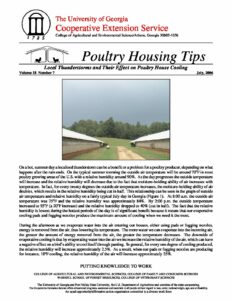On a hot, summer day a localized thunderstorm can be a benefit or a problem for a poultry producer, depending on what happens after the rain ends. On the typical summer morning the outside air temperature will be around 70oF in most poultry growing areas of the U.S. with a relative humidity around 90%. As the day progresses the outside temperature will increase and the relative humidity will decrease due to the fact that moisture-holding ability of air increases with temperature. In fact, for ev...ery twenty degrees the outside air temperature increases, the moisture-holding ability of air doubles, which results in the relative humidity being cut in half. This relationship can be seen in the graph of outside air temperature and relative humidity on a fairly typical July day in Georgia (Figure 1). At 8:00 a.m. the outside air temperature was 75oF and the relative humidity was approximately 84%. By 2:00 p.m. the outside temperature increased to 95oF (a 20oF increase) and the relative humidity dropped to 40% (cut in half). The fact that the relative humidity is lowest during the hottest periods of the day is of significant benefit because it means that our evaporative cooling pads and fogging nozzles produce the maximum amount of cooling when we need it the most.
Details
| Year | Volume | Number | Categories |
|---|---|---|---|
| 2006 | 18 | 7 |

